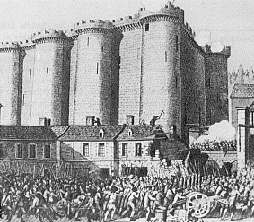French Revolution 2: Reforms
EVENTS

|
Storming of the Bastille |
- In 1788 Louis XVI was forced to summon the Estates General. This body immediately agitated for expanded rights, calling itself the National Assembly.
- July 14, 1789. Storming of the Bastille. This prison was more a symbol of political oppression than its reality. Paris was now ruled by revolutionaries.
- August 4, 1789. Abolition of feudalism.
- October, 1789. March on Versailles and an attempt on the life of Marie Antoinette. The King became a virtual prisoner in the Tuileries.
- Constitution of 1791. Established the government as a hereditary constitutional monarchy. Other elements of the new system were: A parliament consisting of a single elected chamber (the Legislative Assembly), a separate executive (with no power to make laws), and a "suspensive" veto for the King. All judges were to be elected, and the franchise was to be given to all that paid taxes equivalent to 3 days wages or more.
- By 1792, the French were at war against Austria and an alliance of European nations who greatly feared the uprising. The badly trained army suffered significant defeats.
- August 10, 1792. A mob invaded the Tuileries and the king asked for the protection of the National Assembly. The government was at a crisis point.
REFORMS

|
The tricolor flag was introduced in 1794. Learn more |
The revolutionary government enacted numerous laws that were meant to reform nearly every aspect of French life, from its ruling principles to the patterns of daily life. Among these we find:
- The Development of Local Government and Departments
- France was divided into 83 departments, each with the same laws, customs, weights and measures. Internal Tariffs were also abolished in France, getting rid of pockets of inequality.
- The System of Justice
- Reform allowed for open public trials and abolished the hated Lettres de Cachet. All social classes were tried in the same courts, with a court of final appeal for civil and criminal cases, and a high court for cases of treason. Vague ideological crimes such as heresy and magic were abolished. There was a court of final appeal for civil and criminal cases and a high court for cases of treason.
- Freedom of the Press
- The press was now free to criticize etc. The freedom of the press was absolute and this led to it becoming a form of propaganda. It was instrumental in the rise of principal figures such as Robespierre and Danton.
- Military Forces
- Early in 1789 revolutionary committees of sailors and soldiers were formed. This often caused conflict with the regular army and navy. In February 1790 the forces were made responsible to the National Assembly. This effectively took from Louis any chance of using the military to regain his position of influence.
- The Catholic Church
- Church property was confiscated (1789) and it was to be sold at auction. The clergy were to be paid by the state, although the system for support of clergy was not financially sound and created inflationary pressures.
The Civil Constitution of the clergy required the clergy to take an oath to the state, not just to Rome. They were also to be elected. This succeeded in alienating the clergy (especially the lower clergy, like the parish priests) from the Revolution and outraged Louis XVI. Strongly catholic areas like Anjou were increasingly disaffected by such policies.
- Calendar, weights and measures
-
In 1790 the French Academy recommended a new system of units, based on the ideas that first, the system should consist of measuring units based on invariable quantities in nature; second, all units other than the base units should be derived from these base units, and third, multiples and sub-multiples of the units should be decimal. The metric system replaced a hodge-podge of measurement units and is the basis of the modern Système International d'Unités, abbreviated as SI.
Part 3: The Terror
Websites of Interest
- Liberty, Equality, Fraternity. Exploring the French Revolution
- American Social Productions, Inc. A rich site full of original documents and interpretative essays. The principal authors are Lynn Hunt and Jack Censer.
- Declaration of the Rights of Man and of the Citizen
- Approved by the National Assembly of France, August 26, 1789. In English
- French Revolution
-
-



 Return to
Return to